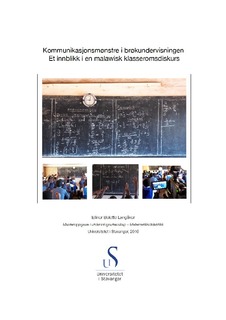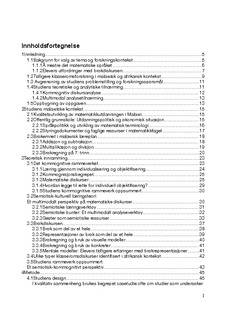| dc.contributor.advisor | Bjuland, Raymond | |
| dc.contributor.author | Langåker, Ellinor Bolette | |
| dc.date.accessioned | 2016-08-08T11:19:48Z | |
| dc.date.available | 2016-08-08T11:19:48Z | |
| dc.date.issued | 2016-06-13 | |
| dc.identifier.uri | http://hdl.handle.net/11250/2398142 | |
| dc.description | Master's thesis in Didactics of mathematics for primary school | nb_NO |
| dc.description.abstract | Sammendrag
I denne masteroppgaven presenteres en kvalitativ klasseromsstudie. Den har undersøkt brøkundervisning i en malawisk kontekst med fokus på hvordan brøk og brøkregning ble representert og kommunisert i undervisningen. Studien følgte en lærers undervisning på 7. trinn gjennom en periode på to uker. Totalt åtte undervisningsøkter ble observert. Videoopptak fra disse øktene utgjør studiens empiriske datamateriale. Kommunikasjonen i klasserommet ble studert ut fra et sosiokulturelt perspektiv, med hensikt på hvilke muligheter for læring av brøk malawiske elever tilbys gjennom undervisningen. Studiens funn er i stor grad basert på diskursanalyse av de innsamlede videoobservasjonene. Klasseromsdiskursen ble sett i lys av kommognitiv teori. I tillegg ble semiotisk-kulturelle verktøy brukt til å identifisere semiotiske ressurser i diskursen og tolke den gjennom et multimodalt perspektiv. Verbal tale, gester og symboler var et gjennomgående fokus i studien.
Resultatene fra studien viste at undervisningen i stor grad var orientert mot gjennomføring av matematiske rutiner. Ved å studere det semiotiske innholdet i klasserommet i detalj kom nyanser og forskjeller i undervisningen frem i lyset: Interaksjonen mellom lærer og elever så ut til å følge ulike gjentakende mønstre. Dette resulterte i at fem ulike kommunikasjonsmønstre ble identifisert og kategorisert som ulike diskurser. De tre mest sentrale diskursene ble videre analysert og diskutert. Analysen indikerte at kommunikasjonsmønstrene i diskursene var etablerte i klasserommet i ulik grad. Kommunikasjon om rutiner som var velkjente for elevene følgte et gjentakende og repetitivt mønster. Hvordan de semiotiske ressursene opptrådte i klasserommet, særlig lærerens bruk av gester, indikerte at også interaksjonen i de mindre etablerte diskursene så ut til å tendensere mot et lignende mønster. Felles for diskursene var at symbolske representasjoner av brøk var sentralt. Resultatene indikerte også at mulighetene for læring av brøk varierte fra diskurs til diskurs. Blant annet så divisjon med brøk ut til å være en ekstra utfordring for elevene og studien foreslo at dette kunne ha sammenheng med hvordan rutinen ble representert og kommunisert i undervisningen. Studien konkluderte med at den observerte undervisningen med fordel kunne inkludere flere og mer varierte brøkrepresentasjoner for å legge til rette for hensiktsmessige læringsprosesser i klasserommet. | nb_NO |
| dc.description.abstract | Abstract
This master thesis presents a qualitative case study following the teaching of a Malawian teacher in the topic of fractions in 7th grade, focusing on how fractions and numeric operations on fractions are represented and communicated in the classroom during a period of two weeks. Classroom interactions were analyzed to consider learning potentials offered to Malawian students through this teaching. Video recordings from eight lessons make up the empirical material of the study. The findings of the study were mainly based on discourse analysis of the collected video observations. The analysis was rooted in socio-cultural learning theories. Commognitive theories functioned as the study´s central theoretical framework. Additionaly, a semiotic-cultural tool was used in order to add a multimodal perspective to the analysis. The discourse was described through identifying the occurance and use of semiotic resources in the classroom. Speech, gestures and symbols were the main focus of the analysis.
Findings implied that the teaching was oriented mainly towards carrying out mathematical routines. By studying the semiotic contents of the teaching, nuances appeared in the material. The interactions between the teacher and students seemed to follow different repeating patterns of communication. Five communicational patterns were identified and classified as different discourses. The three discourses that represented the teaching best as a whole, were then more thoroughly analyzed. This analysis concidered what potential learning outcome of fractions the teaching could provide for the students who participated in the teaching of the topic. The results of the study suggested that the different discourses were established in the classroom to varying degrees. In mathematical routines familiar to the students, the classroom interaction seemed to follow a repetitive pattern. Analysis of the teachers´ gestures suggested that the interaction in the two less established discourses were on an evolving path towards the same direction. Amongst several common features of the discourses, the study found that symbolic representations were highly central to the communication of fractions. Division of fractions came across as especially challenging for the students. The latter seemed to be related to the semiotic means used to represent and communicate fractions in the teaching. As a main suggestion the study argued that a larger variety of representations of fractions should be implemented in the teaching, to facilitate and promote appropriate learning processes for the students.
Keywords:
Mathematical discourse * Visual mediators * Symbolic representation
Semiotic resources * Gestures * Fractions * Numerical operations on fractions * Malawi | nb_NO |
| dc.language.iso | nob | nb_NO |
| dc.publisher | University of Stavanger, Norway | nb_NO |
| dc.rights | Navngivelse 3.0 Norge | * |
| dc.rights.uri | http://creativecommons.org/licenses/by/3.0/no/ | * |
| dc.subject | matematikkdidaktikk | nb_NO |
| dc.subject | visuelle mediatorer | nb_NO |
| dc.subject | symbolske representasjoner | nb_NO |
| dc.subject | gester | nb_NO |
| dc.subject | semiotiske ressurser | nb_NO |
| dc.subject | brøk | nb_NO |
| dc.subject | brøkregning | nb_NO |
| dc.subject | matematiske diskurser | nb_NO |
| dc.subject | undervisningskunnskap i matematikk | nb_NO |
| dc.subject | Malawi | nb_NO |
| dc.title | Kommunikasjonsmønstre i brøkundervisningen. Et innblikk i en malawisk klasseromsdiskurs | nb_NO |
| dc.title.alternative | Patterns of communication in teaching fractions. A look into the discourse of a Malawian classroom | nb_NO |
| dc.type | Master thesis | nb_NO |
| dc.subject.nsi | VDP::Social science: 200::Education: 280::Subject didactics: 283 | nb_NO |


